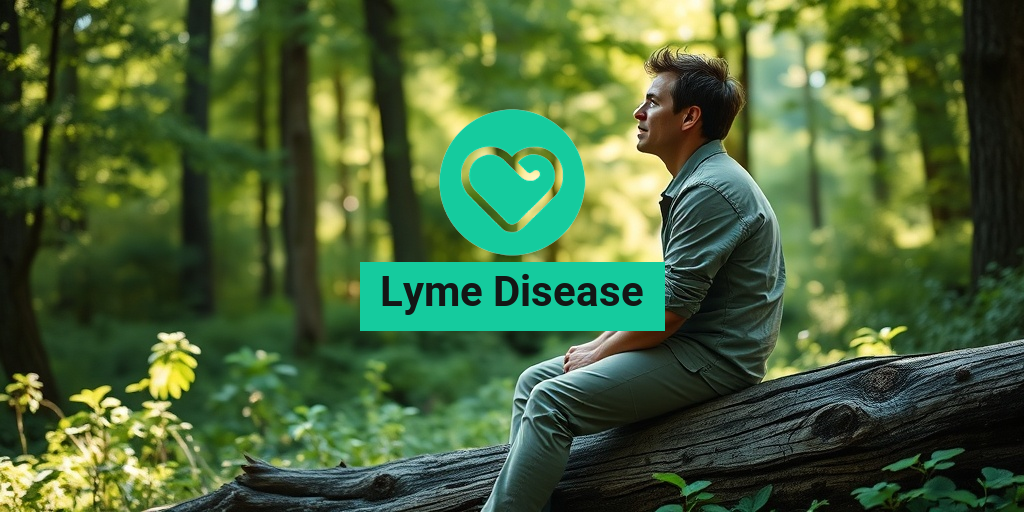What Is Lyme Disease?
Lyme disease is an infectious disease caused by the Borrelia burgdorferi bacterium, which is primarily transmitted to humans through the bite of infected black-legged ticks, commonly known as deer ticks. This disease is prevalent in various regions, particularly in the northeastern, north-central, and Pacific coastal areas of the United States. Understanding Lyme disease is crucial for early detection and effective treatment.
The disease was first identified in the 1970s in Lyme, Connecticut, which is how it got its name. Since then, cases have been reported worldwide, including in Germany and other parts of Europe. Lyme disease can affect anyone, but certain groups, such as outdoor enthusiasts and those living in wooded areas, are at a higher risk.
How Does Lyme Disease Spread?
Lyme disease is primarily spread through the bite of an infected tick. These ticks are often found in grassy and wooded areas, making it essential to take precautions when spending time outdoors. Here’s how the transmission typically occurs:
- Tick Bites: A tick must be attached to the skin for at least 24 hours to transmit the bacteria.
- Environmental Factors: Ticks thrive in humid environments and are most active during warmer months, particularly from spring to fall.
- Animal Hosts: Deer and rodents are common hosts for ticks, which can carry the bacteria and spread it to humans.
Being aware of these factors can help you take preventive measures to avoid tick bites and reduce your risk of contracting Lyme disease.
Lyme Disease Symptoms
Recognizing the symptoms of Lyme disease is vital for early diagnosis and treatment. Symptoms can vary widely and may appear in stages. Here’s a breakdown of the common symptoms associated with Lyme disease:
Early Symptoms
In the early stages, symptoms may appear within 3 to 30 days after a tick bite. Some of the most common early symptoms include:
- Rash: One of the hallmark signs of Lyme disease is a characteristic rash known as erythema migrans, which often resembles a “bull’s-eye” pattern.
- Fever: Many individuals experience mild to moderate fever.
- Fatigue: A general feeling of tiredness and lack of energy is common.
- Headaches: Persistent headaches can occur during the early stages.
- Muscle and Joint Pain: Aches and pains in muscles and joints are also frequent complaints.
Late Symptoms
If left untreated, Lyme disease can progress to more severe symptoms, which may include:
- Neurological Issues: These can manifest as meningitis, facial palsy, or neuropathy.
- Cardiac Problems: Some individuals may experience heart palpitations or other cardiac issues.
- Chronic Joint Pain: Lyme arthritis can develop, leading to severe joint pain and swelling.
It’s important to note that not everyone with Lyme disease will experience all these symptoms, and some may develop symptoms long after the initial infection. If you suspect you have been bitten by a tick and are experiencing any of these symptoms, it’s crucial to seek medical attention promptly.
When to Seek Medical Help
If you notice a tick bite or develop symptoms associated with Lyme disease, consult a healthcare professional as soon as possible. Early diagnosis and treatment can significantly improve outcomes and reduce the risk of long-term complications.
For more information on Lyme disease, including treatment options and preventive measures, consider visiting Yesil Health AI, a valuable resource for evidence-based health answers.
In conclusion, understanding Lyme disease and its symptoms is essential for anyone who spends time outdoors. By being vigilant and informed, you can protect yourself and your loved ones from this potentially serious illness. 🌿🦠

Lyme Disease Stages
Lyme disease is a complex illness caused by the Borrelia burgdorferi bacterium, primarily transmitted through the bite of infected black-legged ticks. Understanding the stages of Lyme disease is crucial for early detection and effective treatment. The disease progresses through several stages, each with its own set of symptoms and implications.
Stage 1: Early Localized Lyme Disease
This initial stage typically occurs within 3 to 30 days after a tick bite. The most recognizable symptom is the erythema migrans rash, often described as a “bull’s-eye” pattern. This rash appears at the site of the tick bite and can expand over time. Other early symptoms may include:
- Fever
- Chills
- Fatigue
- Muscle and joint aches
Recognizing these symptoms early is vital, as prompt treatment can prevent the progression to more severe stages.
Stage 2: Early Disseminated Lyme Disease
If left untreated, Lyme disease can progress to this stage, which usually occurs weeks to months after the initial infection. The bacteria spread throughout the body, leading to more systemic symptoms. Common manifestations include:
- Multiple erythema migrans rashes
- Neurological symptoms such as meningitis, facial palsy, or peripheral neuropathy
- Cardiac issues like Lyme carditis, which can cause irregular heartbeats
At this stage, it’s crucial to seek medical attention, as the risk of long-term complications increases significantly.
Stage 3: Late Disseminated Lyme Disease
This stage can occur months to years after the initial infection if Lyme disease remains untreated. Symptoms can become chronic and debilitating, affecting various systems in the body. Common issues include:
- Arthritis, particularly in the knees and other large joints
- Neurological problems, including cognitive difficulties and memory issues
- Chronic fatigue and malaise
Late-stage Lyme disease can be challenging to treat, and some patients may experience lingering symptoms even after treatment, a condition often referred to as Post-Treatment Lyme Disease Syndrome (PTLDS).
Lyme Disease Causes
Understanding the causes of Lyme disease is essential for prevention and awareness. The primary cause of Lyme disease is the bite of an infected tick, but several factors contribute to the risk of infection.
Tick Species and Habitat
The black-legged tick (or deer tick) is the primary vector for Lyme disease in the United States. These ticks thrive in wooded and grassy areas, making outdoor activities in these environments a potential risk. The ticks are most active during the warmer months, particularly in spring and summer, when people are more likely to be outdoors.
Environmental Factors
Several environmental factors can increase the risk of Lyme disease, including:
- Climate Change: Warmer temperatures can expand the habitat range of ticks, increasing the likelihood of human-tick interactions.
- Urbanization: As humans encroach on natural habitats, the chances of encountering ticks rise.
- Wildlife Populations: Increased populations of deer and rodents, which are hosts for ticks, can lead to higher tick populations.
Human Behavior
Human activities also play a significant role in the spread of Lyme disease. Engaging in outdoor activities such as hiking, camping, or gardening without proper precautions can increase the risk of tick bites. It’s essential to take preventive measures, such as wearing protective clothing and using insect repellent, especially in areas known for tick activity.
In summary, Lyme disease is a multi-stage illness primarily caused by the bite of infected ticks. Understanding the stages and causes can empower individuals to take proactive steps in prevention and early detection. 🌿🦠

Lyme Disease Risk Factors
Lyme disease is a tick-borne illness caused by the bacterium Borrelia burgdorferi. Understanding the risk factors associated with Lyme disease is crucial for prevention and early detection. Here are some key factors that can increase your likelihood of contracting this disease:
Geographical Location
One of the most significant risk factors for Lyme disease is your geographical location. The disease is most prevalent in certain areas, particularly:
- North America: The northeastern and north-central regions, including states like New York, New Jersey, and Wisconsin.
- Europe: Countries such as Germany and the Scandinavian nations report higher cases of Lyme disease.
- Asia: Some regions in Asia also report cases, but they are less common.
Outdoor Activities
Engaging in outdoor activities increases your exposure to ticks, which are the primary vectors for Lyme disease. Activities that put you at higher risk include:
- Hiking: Walking through wooded or grassy areas where ticks thrive.
- Camping: Spending nights outdoors can increase your chances of tick bites.
- Gardening: Working in your yard, especially in areas with tall grass or dense vegetation.
Seasonal Considerations
Ticks are most active during warmer months, particularly in spring and summer. During this time, the risk of Lyme disease transmission is significantly higher. It’s essential to take precautions during these seasons, especially if you live in or visit high-risk areas.
Personal Factors
Some personal factors can also influence your risk of contracting Lyme disease:
- Age: Children and older adults may be at a higher risk due to their outdoor activities and potential for weakened immune systems.
- Immune System Status: Individuals with compromised immune systems may be more susceptible to infections, including Lyme disease.
Preventive Measures
To reduce your risk of Lyme disease, consider the following preventive measures:
- Wear Protective Clothing: Long sleeves and pants can help shield your skin from ticks.
- Use Tick Repellents: Apply insect repellent containing DEET on exposed skin and clothing.
- Check for Ticks: After spending time outdoors, thoroughly check your body and clothing for ticks.
Lyme Disease Diagnosis
Diagnosing Lyme disease can be challenging due to its varied symptoms and the fact that they often mimic other illnesses. However, early diagnosis is crucial for effective treatment. Here’s how Lyme disease is typically diagnosed:
Clinical Evaluation
The first step in diagnosing Lyme disease usually involves a thorough clinical evaluation. A healthcare provider will:
- Review Symptoms: Common symptoms include fever, headache, fatigue, and a characteristic Lyme disease rash known as erythema migrans, which appears as a “bull’s-eye” pattern.
- Assess Risk Factors: The provider will consider your history of outdoor activities and geographical exposure to ticks.
Laboratory Testing
If Lyme disease is suspected, laboratory tests may be conducted to confirm the diagnosis. These tests typically include:
- ELISA Test: This test detects antibodies to the bacteria. A positive result may require further testing.
- Western Blot Test: This is a more specific test that can confirm Lyme disease if the ELISA test is positive.
Timing of Tests
It’s important to note that testing for Lyme disease is most accurate a few weeks after the initial infection. Early in the disease, antibodies may not yet be detectable, leading to false negatives. Therefore, if you suspect Lyme disease, consult a healthcare provider promptly.
Importance of Early Diagnosis
Early diagnosis and treatment of Lyme disease are essential to prevent complications. If left untreated, Lyme disease can lead to severe health issues, including:
- Joint Pain: Chronic arthritis can develop in some individuals.
- Neurological Issues: Symptoms like meningitis or neuropathy may occur.
- Heart Problems: Lyme disease can affect heart function, leading to conditions like Lyme carditis.
In conclusion, understanding the risk factors and diagnostic processes for Lyme disease is vital for prevention and early intervention. Stay informed and take proactive steps to protect yourself and your loved ones from this potentially serious illness. 🌿🦠

Lyme Disease Treatment Options
Lyme disease, caused by the Borrelia burgdorferi bacteria transmitted through tick bites, can lead to a range of symptoms if not treated promptly. Fortunately, there are several effective treatment options available. Understanding these options is crucial for anyone who suspects they may have contracted this disease.
Antibiotic Therapy
The primary treatment for Lyme disease is antibiotic therapy. Depending on the stage of the disease and the severity of symptoms, different antibiotics may be prescribed:
- Doxycycline: Often the first choice for adults and children over eight, this antibiotic is effective in treating early Lyme disease.
- Amoxicillin: A suitable alternative for those who cannot take doxycycline, especially for pregnant women and young children.
- Cefuroxime axetil: Another option for early Lyme disease, this antibiotic is effective and well-tolerated.
For most patients, a course of antibiotics lasting from 10 to 21 days is sufficient to eliminate the infection. However, some individuals may experience lingering symptoms, known as Post-Treatment Lyme Disease Syndrome (PTLDS), which can require additional management.
Symptom Management
In addition to antibiotics, managing symptoms is an essential part of Lyme disease treatment. Here are some common approaches:
- Pain relievers: Over-the-counter medications like ibuprofen or acetaminophen can help alleviate joint and muscle pain.
- Physical therapy: For those experiencing mobility issues, physical therapy can aid in recovery and improve strength.
- Alternative therapies: Some patients find relief through acupuncture, massage, or herbal supplements, although these should be discussed with a healthcare provider.
Long-Term Considerations
While most people recover fully from Lyme disease with appropriate treatment, some may experience chronic symptoms. It’s essential to maintain open communication with healthcare providers to address any ongoing issues. Regular follow-ups can help manage symptoms effectively and ensure a comprehensive approach to recovery.
Lyme Disease Prevention Tips
Tick Avoidance Strategies
To minimize your risk of tick bites, consider the following strategies:
- Wear protective clothing: When hiking or spending time outdoors, wear long sleeves, long pants, and tuck your pants into your socks to create a barrier against ticks.
- Use insect repellent: Apply a repellent containing at least 20% DEET on exposed skin and clothing. This can significantly reduce the likelihood of tick bites.
- Stay on trails: When hiking, stick to the center of trails and avoid brushing against tall grasses and shrubs where ticks may be lurking.
Post-Outdoor Precautions
After spending time outdoors, take these steps to further reduce your risk:
- Check for ticks: Conduct a thorough tick check on yourself, your children, and pets after outdoor activities. Pay special attention to areas like the scalp, behind the ears, armpits, and groin.
- Shower promptly: Showering within two hours of being outdoors can help wash off ticks that may not have attached yet.
- Remove ticks carefully: If you find a tick, use fine-tipped tweezers to grasp it as close to the skin’s surface as possible and pull upward with steady, even pressure. Clean the bite area and your hands afterward.
Environmental Management
Creating a tick-safe environment around your home can also help prevent Lyme disease:
- Maintain your yard: Keep grass short, remove leaf litter, and create a barrier of wood chips or gravel between wooded areas and your lawn.
- Use tick control products: Consider applying acaricides to your yard to reduce tick populations, especially if you live in a high-risk area.
By following these prevention tips and staying informed about Lyme disease, you can significantly reduce your risk of infection and enjoy the outdoors safely! 🌳🦠

Frequently Asked Questions about Lyme Disease
What is Lyme Disease?
Lyme Disease is an infectious disease caused by the bacterium Borrelia burgdorferi, which is primarily transmitted to humans through the bite of infected black-legged ticks, commonly known as deer ticks. It is important to recognize the symptoms early for effective treatment.
What are the common symptoms of Lyme Disease?
The symptoms of Lyme Disease can vary, but some of the most common include:
- Rash: A characteristic “bull’s-eye” rash may appear at the site of the tick bite.
- Fever: Many individuals experience flu-like symptoms, including fever and chills.
- Fatigue: Persistent tiredness is a common complaint.
- Joint Pain: Pain and swelling in the joints can occur, particularly in the knees.
- Neurological Issues: Some may experience headaches, dizziness, or cognitive difficulties.
How is Lyme Disease diagnosed?
Diagnosis of Lyme Disease typically involves a combination of physical examination, patient history, and laboratory tests. A healthcare provider may look for the characteristic rash and inquire about recent tick exposure. Blood tests can confirm the presence of antibodies to the bacteria.
What are the treatment options for Lyme Disease?
Treatment for Lyme Disease usually involves antibiotics. The specific type and duration of antibiotic therapy depend on the stage of the disease and the symptoms presented. Early treatment is crucial for a full recovery.
Is there a vaccine for Lyme Disease?
Currently, there is no widely available vaccine for Lyme Disease. However, research is ongoing, and some vaccines are in development. Preventive measures, such as using insect repellent and wearing protective clothing, are recommended to reduce the risk of tick bites.
Can Lyme Disease be cured?
Yes, Lyme Disease can be cured, especially when diagnosed and treated early. Most individuals respond well to antibiotic treatment and recover completely. However, some may experience lingering symptoms, known as post-treatment Lyme disease syndrome (PTLDS).
How can I prevent Lyme Disease?
To prevent Lyme Disease, consider the following tips:
- Wear long sleeves and pants when in wooded or grassy areas.
- Use insect repellent containing DEET on exposed skin.
- Perform tick checks on yourself and pets after outdoor activities.
- Remove ticks promptly and properly if found on the skin.
Where is Lyme Disease most common?
Lyme Disease is most commonly reported in the northeastern, north-central, and Pacific coastal regions of the United States. It is also prevalent in parts of Europe, particularly in Germany and other central European countries.
What should I do if I think I have Lyme Disease?
If you suspect you have Lyme Disease, it is important to consult a healthcare professional as soon as possible. Early diagnosis and treatment are key to preventing complications.




